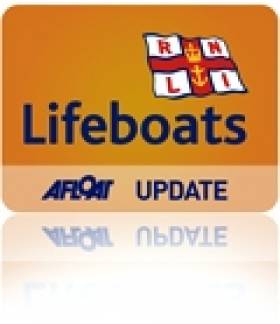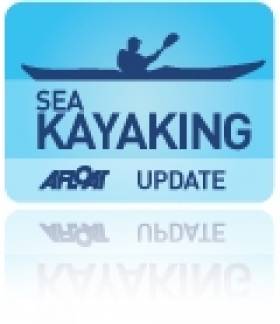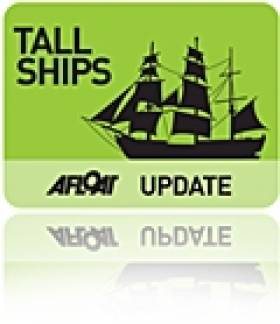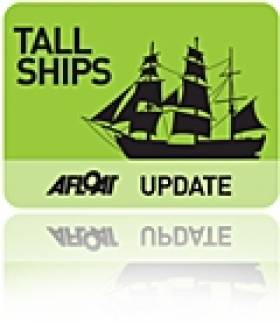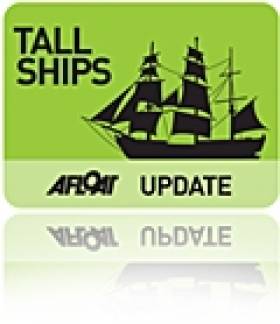Displaying items by tag: Tall Ships
#TallShips - The Atlantic Youth Trust's Neil O'Hagan has described as "a major breakthrough" the sail training initiative's inclusion in the Government's recently announced Capital Plan for the next five years.
"This is the first clear, public commitment from [the] Government that they intend to work with sources in Northern Ireland to deliver our plans [to build a replacement for the tall ship Asgard II]," said O'Hagan. "More importantly, it is a clear commitment by the Government to invest in youth development, the maritime sector, and cross-border relations.
"Our messaging and objectives have carried through as it states 'This proposal involves a new sail training vessel to facilitate youth development, mentoring, and training on an all-island basis.' When combined with the commitment from Northern Ireland to appoint a representative from the Department of Employment and Learning, this shows true all-island support."
The trust's proposals for a new sail training tall ship for Ireland have already attracted the support of a group of influential business people including financier Dermot Desmond,Denis O'Brien and CPL Resources founder Anne Heraty.
Tallship Tours of German Navy Sail Training Ship This Sunday
#TallShipTours – As a reminder the German Navy three-masted barque Gorch Fock, which is currently on a visit of Dublin since arriving last week, will be open to public tours next Sunday (13th September), writes Jehan Ashmore.
In addition the 1958 built tallship which is berthed at Sir John Rogersons Quay will also be open again for the public on the following Sunday (20th September).
Tour times for both of the “Open Ship” days are between 2-5pm, where her crew will welcome you on board her timber decks.
So why not make a visit (free of charge and no registration) on board the sail training ship that has toured the world 168 times.
The primary mission of the Gorch Fock is to provide basic nautical training for officer and non-commissioned officer candidates of the German Navy combining theoretical and practical aspects.
The focus is on the training of the officer candidates, the so-called cadets who climb the rigging in which the masts tower just over 45 metres above the sea.
On board the tall ship, the cadets get their sea legs. They are to experience first hand what it means to work as a team at sea, "to pull together" and "to be in the same boat".
On a sail training ship, this is easily put into practice as the main means of propulsion, the rigging, is operated by muscle power only.
Gorch Foch is to remain in port until the 21st September when she sets sails to Funchal, Portugal. After this first port of call on the Iberian Peninsula, she heads to Cadiz in neighbouring Spain.
She then returns across the Bay of Biscay with the final leg to take place in November from Dartmouth back to the German port of Wilhelmshaven.
#RNLI - The RNLI will have a fully operational lifeboat station in Belfast City from 9am tomorrow 2 July right through to Sunday evening 5 July for the Tall Ships Races.
With up to 750,000 visitors expected in Belfast over the next four days, a number of volunteers from Bangor and Red Bay lifeboat stations will be on call to provide a 24-hour search and rescue service during the event.
The crew will operate from a temporary lifeboat station located in Belfast Harbour Marina and will respond to any emergency on Belfast Lough using an Atlantic 85 relief lifeboat.
During the Tall Ships Parade on Sunday, both the Atlantic 85 lifeboat and an all-weather Trent class lifeboat crewed by Donaghadee RNLI will be operational on Belfast Lough for search and rescue capabilities.
Speaking ahead of the Tall Ships Races, RNLI divisional operations manager Darren Byers said: "For the duration of the weekend and specifically to accommodate the large numbers expected to descend on Belfast to watch the Tall Ships spectacle, the RNLI will be fully operational at the heart of where all the activities will be taking place.
"Belfast RNLI will operate for four days only supported by its nearest lifeboat stations at Bangor and Larne. This means should there be an emergency during the event, we can reduce the time it takes to get on scene while maintaining a business as usual operation at our flank lifeboat stations."
The RNLI will have a significant presence on site throughout the weekend and has been honoured to be chosen by Tall Ships Belfast as one of five key maritime charities to benefit.
As well as a fully operational lifeboat station, the RNLI will have an all-weather Trent class lifeboat afloat which can be viewed from the quayside at Belfast Harbour Marina. Volunteer lifeboat crew will be on hand to answer any questions and to demonstrate how they use the lifeboat for search and rescue.
RNLI lifeguards who patrol 10 beaches in Northern Ireland during the summer season will also be displaying the rescue water craft and lifesaving kit they use.
Visitors to the RNLI areas can also take part in the ‘Get Your Kit on Challenge’. This is a timed challenge that pits members of the public against the clock to see how long it takes them to put on an inshore lifeboat crew member’s full kit: dry suit with yellow wellies, lifejacket with crotch straps and helmet. The lifeboat crew do this in seconds as they race to launch the lifeboat on a callout.
RNLI community fundraising manager Nicola Kelly is looking forward to the event. "The RNLI is hosting a variety of engaging activities at Tall Ships Belfast and we are honoured to have been selected as one of the official charities to benefit," she said.
"We are looking forward to welcoming visitors to the RNLI areas and hope that in doing so we can provide an entertaining, informative and interesting aspect to the full programme being provided.
"As well as saving lives at sea and on inland waters, the RNLI also provides education along with sea safety advice and demonstrations and we hope spectators can sample a flavour of that this weekend."
Belfast’s £5m Lagan Weir Bridge Opens
#NewLaganBridge - A new bridge across the River Lagan in Belfast reports UTV News has been opened by Social Development Minister Mervyn Storey MLA.
Connecting Donegall Quay with Queen's Quay the new Lagan Weir Pedestrian and Cycle Bridge replaces the old footbridge and represents a £5m investment in the city from the department.
Speaking at the official opening, Minister Storey said, "I am delighted to officially open the new Lagan Weir pedestrian and cycle bridge.
"This magnificent bridge considerably improves the connection from Belfast city centre to Queen's Quay, and showcases the potential for development in this area."
With 16,000 people crossing the old footbridge each week, it is anticipated that the new Bridge will be well utilised, offering access - for the first time - to both pedestrians and cyclists.
The Minister added: "My department is committed to implementing the Queen's Quay Masterplan and this is the first stage in that process.
"The Queen's Quay Masterplan sets out an exciting vision of the development potential of this area, and the creation of this new bridge will improve the links between the city centre and Queen's Quay, as well as the Titanic Quarter."
The new bridge, which is approximately eight metres across at its widest point, was constructed by Graham Construction and has been completed in time for the Tall Ships 2015 event.
Afloat.adds this is the third time Belfast City has hosted the Tall Ships Race where more than 50 tall ships will be visiitng the harbour for a four-day festival beginning tomorrow, Thursday (2 July).
For more on this new bridge spanning the Lagan, click here.
#Kayaking - A German entrepreneur living in Cork is making his way home to meet the Tall Ships festival in an unique manner, as the Irish Examiner reports.
While Belfast Lough prepares to welcome the start of the Tall Ships Races next week, Hendrik Lepel is kayaking from Kinsale to his hometown of Rostock – via St George's Channel and around the English coast to Calais and onwards past the Low Countries to northern Germany and the Kiel Canal – in time to meet the tall ships after their race concludes in Denmark in mid August.
Despite "not being experienced" at offshore kayaking, Lepel left Kinsale on Saturday 20 June well prepared for nearly two months at sea, with the right provisions, safety and communications gear.
“I will stop every night when I can and get on to land, where possible," he said. "I can also put the kayak under sail if I need to."
Lepel, who runs a business manufacturing pizza ovens, will be padding in The Flying Northman, a sophisticated vessel that's more like a trimaran than a traditional kayak.
The Irish Examiner has more on the story HERE.
One Week Countdown to Belfast Tall Ships Arrival
#BelfastTALLships - Excitement is building in the air as Belfast City has just one week to go before the biggest spectator event is ever staged in Northern Ireland.
The city will act as the home port before the start of the 2015 Tall Ships Race, with dozens of the world's finest sailing vessels berthed in Belfast over the weekend of July 2 - 5.
This is the third time that Belfast has welcomed the Tall Ships Race, having previously staged the event in 1991 and 2009. However, with the city acting as the staging post for the first leg of the race, even more ships will be taking part this year, with some 50 vessels – including 18 massive Class A ships – making the port their home for four days before setting off on their annual challenge.
More than 500,000 people are expected to attend the free event, bringing with them an economic windfall of at least £10 million for the city. The same number are expected to line the shores of Belfast Lough on the Sunday (July 5) to watch the magnificent Parade of Ships as they leave en masse for the first leg of this year's race, which starts off Portrush the following morning.
As well as the ships – many of which will be open to the public (subject to occasional operational restrictions) – there will be plenty to do and see on land, with a packed entertainments programme, headed by teenage pop sensations Bailey McConnell and Emma Horan, as well as a host of local talent.
There'll also be fun fairs, street theatre, interactive activities, food markets, a fireworks display on the Saturday night and a fly past by the Royal Arrows on the Sunday morning.
Translink are laying on special services to get people safely to and from the Tall Ships. There will be Park and Ride facilities at Sprucefield, Cairnshill, Dundonald and a new site at Ballymartin, just off the M2 at the junction for the International Airport.
There also will be bus services from Belfast City Council Park and Ride sites at Holywood Exchange travelling to Queen's Quay and from Boucher Road Playing Fields to Pollock Dock.
A free shuttle bus will help ferry visitors from Wellington Place in the city centre to Pollock Dock, and another between there and Queen's Quay.
For details of these, and all Translink's special services and offers, visit www.translink.co.uk/tallships/ or call the Translink contact centre on 9066 6630
For further information on the events taking place over the weekend, the ships and where they will be berthed, the ancillary entertainments' programme, the best vantage points for the Parade of Sail, and much more, visit www.tallshipsbelfast.com
You can also keep up to date with news at www.facebook.com/tallshipsbelfast and www.twitter.com/tallships2015
For tourist information, contact Visit Belfast on +44(0)28 9024 6609 or click www.visit-belfast.com
#TallShips - Dun Laoghaire Marina has put out a reminder to watch for a special visitor to the harbour this coming Thursday 28 May in the shape of the tall ship Kaskelot.
The Baltic Trader, which dates from 1948, was converted to replicate a traditional barque for film and TV productions such as Return to Treasure Island and Shackleton, and later restored at Gloucester's historic docks.
More recently Kaskelot has been touring the British Isles for the summer season, departing Bristol on 14 March with stops in Plymouth, Poole, Weymouth and Fowey before a cross-channel jaunt to the Gulf of Morbihan in Brittany, then back north to Liverpool for the Sound City Music Festival, from where she sets sail to Dublin this week.
It's just a flying visit, though, as Kaskelot is due in Dartmouth on 6 June. The ship's official website has more HERE.
Jeanie Johnston Replica Famine Tallship Sinks in Value
#JeanieJohnston - The Irish Times reports that the replica famine tallship, Jeanie Johnston which cost €15 million to build, has sunk in value to €700,000, according to Dublin City Council.
The ship is part of €8 million in cash and assets expected to transfer to the council as previously reported on Afloat.ie once the Dublin Docklands Development Authority is abolished later this year.
The authority bought the ship in 2005 for €2.7 million from Kerry County Council and other shareholders including food company Kerry Group, Shannon Development Company and Tralee Town Council.
The ship, modelled on a 19th century emigrant ship, was commissioned in the late 1990s for £4.5 million. By the time of its completion in 2002, its cost had spiralled to almost €15.5 million, €13 million of which was State funded.
For more on this story about the tall-ship, click HERE.
#Jeanies€100kbill – The responsibility of Jeanie Johnston soon to be transferred to Dublin City Council faces annual running costs of some €100,000, reports the Herald.ie
The replica famine ship which was undergoing repairs when previously reported on Afloat.ie is among a list of assets that will be handed over from the Dublin Docklands Development Authority (DDDA) to the council when it eventually winds down.
Currently, the ship costs €240,000-a-year to run but ticket sales do not cover all expenses.
The ship is among some key features in the Docklands which will be transferred to the council.
It is also planned to give a €3m cash sum to the council and extra funds to carry improvements on facilities that are not up to scratch.
However, when asked last night if the Jeanie Johnston's repairs (see photo from another report) would be included in this budgeted improvement, the DDDA did not respond.
For more on the story, click here.
50 Days to Go Until Tall Ships Arrive on Belfast Lough
#BelfastTallShips – As of today, there are exactly 50 days to go until 50 of the world's finest Tall Ships begin to arrive on Belfast Lough.
Belfast Harbour will act as the home port before the start of the 2015 Tall Ships Race, with dozens of the world's majestic sailing vessels berthed in city over the weekend of July 2–5.
This is the third time that Belfast has welcomed the Tall Ships Race, having previously staged the event in 1991 and 2009. However, with the city acting as the staging post for the first leg of the race, even more ships will be taking part this year, with some 50 vessels – including 18 massive Class A ships – making the port their home for four days before setting off on their annual challenge.
More than 500,000 people are expected to attend the free event, bringing with them an economic windfall of at least £10 million for the city.
For further information on the events taking place over the weekend, the ships and where they will be berthed, the ancillary entertainments' programme, park and ride facilities and so on.
For info visit www.tallshipsbelfast.com


























